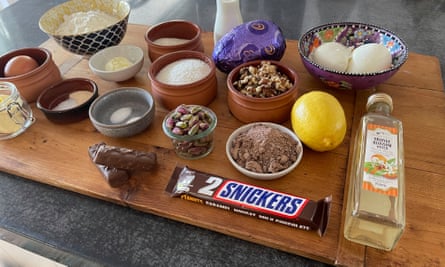
The Muslim holy month of Ramadan ends this weekend when the sighting of the new crescent moon heralds the start of a new lunar month. The previous month of fasting is followed by the three-day festival of Eid al-Fitr, a time for gifts, new clothes, feasting, and for visiting friends and family bearing trays of home-baked sweets.
If you’re Lebanese, or have Muslim friends to visit, you may like to bake maamoul biscuits or jam crescents. You may also like to try these Palestinian pancakes. They’re sold on the streets during Ramadan but are a real treat to make at home.
– Jane Jeffes, founder-producer, Recipes for Ramadan
Sally Mousa’s story
Qatayef is one of the most popular desserts of the Levant and it’s traditionally only eaten during Ramadan.
It’s like a sweet dumpling or little folded pancake. Traditionally, these are stuffed with unsalted akkawi cheese (a white Palestinian cheese with a texture similar to fresh mozzarella), walnuts, pistachios or coconut, then deep-fried and doused in orange blossom syrup (qater) or rosewater syrup. There is also an uncooked version called assafiri qatayef that is filled clotted cream (qashta). Sometimes you will see them shaped into a horn, filled with qashta, and sprinkled with pistachios. Whatever the shape, they’re a sweet way to end the daily Ramadan fast.
One of the greatest sights and aromas of the holy month is walking past street vendors in ancient cities like Jerusalem – they expertly and speedily pour batter into rows of perfectly sized pancakes on a huge hotplate. Similarly, visit any pastry shop and you will be mesmerised by little pancakes bubbling away.
Being Iraqi, I didn’t grow up eating qatayef. It’s a dessert I discovered after I married my Palestinian-Jordanian husband. For him, Ramadan is simply not Ramadan without qatayef.
Living in Sydney away from his family in Amman, my husband craved his mother’s home-cooked food, and so – bearing in mind that we married in 2004 before iPhones and Zoom – I was emailed photos of handwritten recipes from his mother and sister. These recipes didn’t have measurements for the ingredients. Arab mums are absolute masters in the kitchen and there’s a special saying that applies to their craft: “The hand of the free is a scale.” Meaning they know these dishes so well, they are perfect every time without measuring a thing.
When I had my girls, making qatayef together became our own Ramadan tradition. My husband loves the traditional cheese filling but my daughter and I realised dark chocolate and coconut made for a heavenly combination – our very own Bounty qatayef! Another version has a stuffing of chopped-up Snickers.
Sally Mousa’s qatayef, five ways
In this recipe I’m giving you both the traditional versions (with cheese and walnut, and cream), and my Bounty and Snickers versions. And, while qatayef are typically deep-fried, I’ve discovered the texture is superior in an air fryer.
The measurements for the fillings are approximate. Usually you buy (or make) a big batch of qatayef, prepare enough for at least the first half of the month, then freeze them. You can obviously eat as many or as few as you like but, for the larger stuffed ones, about three a person is a generous portion to work on. It’s hard to stop at one!
The method for each version of qatayef is similar. Generally speaking, it involves making or preparing the pancake, making the filling, stuffing the pancake, freezing to set, and frying them. Different variations will have different filling ingredients, and some also have specific syrups, which you can see below.

For the qatayef pancakes
(to make your own, though they can be bought fresh from an Arab bakery or grocery store)
½ tsp active dry yeast
1¾ cups warm water, plus 2 tbsp extra
1 tsp sugar
213g plain flour
100g fine semolina
1 tbsp powdered milk
½ tsp baking powder
Pinch salt
1 egg, beaten
Vegetable oil, for deep-frying or brushing
Slivered or ground pistachios (or nuts of your choice), to garnish
For the cheese and walnut filling
300g sweet akkawi cheese (from Arab bakery or grocery store)
1 cup chopped walnuts
2 tbsp sugar
1 tsp orange blossom water
For the cream filling
100ml ashta or clotted cream (preferably from an Arab bakery or grocery store – it should look thick and layered)
For the Bounty filling
½ cup semi-sweet chocolate chips
½ cup desiccated coconut
2 tbsp sugar
For the Snickers filling
1 bag miniature Snickers bars
For the ater (orange blossom syrup, for the cheese-walnut and cream qatayef)
1 cup sugar
1 tsp orange blossom water
2 tsp lemon juice
For the chocolate syrup (for the Bounty and Snickers qatayef)
⅓ cup cocoa powder
⅓ cup sugar
¼ cup milk or light cream
If you are making the pancakes from scratch, do this first. Stir together the yeast, warm water and sugar and leave the mixture to stand for a few minutes until it becomes foamy. Whisk together the flour, semolina, powdered milk, baking powder, salt and egg to make a thin batter. Cover with plastic wrap and leave to rest for one to two hours in a warm place until the mixture becomes bubbly.
Heat a non-stick pan over medium heat. Pour one-quarter cup of the batter into the pan and use the back of a ladle to swirl the batter into a thin pancake. (If the pancake is too thick, it will be difficult to fill.)
When tiny bubbles form on the surface of the pancake, the surface is no longer shiny, and the bottoms are a light golden colour, the pancake is ready (it only needs to be cooked on one side).
Transfer to a plate, top with a piece of baking paper, and cover with a clean tea towel. Repeat with the remaining batter, stacking the pancakes with baking paper in between each pancake, and keep covered with a clean tea towel as you go.
Leave to cool, then cover with plastic wrap to prevent pancakes from drying out – this is the key to perfect qatayef. When it’s time to fill the pancakes, the edges need to be pinched together. If the pancake is dry, the edges won’t seal.
To fill your qatayef, line a number of small trays with baking paper – the trays should fit your freezer.
For the cheese and walnut filling, drain the akkawi of any excess moisture in a colander. Combine the walnuts, sugar and orange blossom water in a bowl.
For the Bounty filling, combine the chocolate chips, sugar and coconut in a bowl.
For the Snickers version, chop the miniature Snickers into small pieces.
For the cream filling, do not fill these just yet. Reserve some qatayef to fill just before serving, alongside the completed cheese and walnut, Bounty and Snickers qatayef.
To fill your qatayef, take each pancake and place bubble-side up. Place about a teaspoon of your chosen filling in a line in the middle of your pancake. Fold the pancake in half to enclose the filling and, starting from one corner, pinch the edges to seal. Be careful not to overstuff or the pancakes will break open. It’s best to add a conservative amount of filling; at the middle point when sealing the edges you can add a little more filling if necessary. It should look like a pillow. Repeat with the remaining pancakes and your chosen fillings.
Arrange the filled qatayef in one layer on the lined freezer tray place in a freezer bag, securely closed, then freeze for at least two hours. (For ease, each freezer tray should only hold one type of filling.) It’s important to freeze the qatayef so they hold their shape and don’t break open when fried.
For the cheese and walnut or cream-filled qatayef: combine the sugar, a half-cup water, orange blossom water and lemon juice in a small, heavy-based saucepan. Bring to the boil and boil until the syrup is clear. Set aside.
For the Bounty or Snickers qatayef: in a heavy-based saucepan over medium heat, combine all the syrup ingredients and bring to the boil; remove from the heat and set aside.
To fry the qatayef, remove from the freezer and allow to thaw for about 15 minutes.
To deep-fry the qatayef: pour enough oil into a deep pot until the oil is about 5cm deep, and gradually heat to about 180C – the oil is hot enough when a cube of bread browns in about 20 seconds. Gently slide in a few qatayef at at time, taking care not to overcrowd the pot. When they are golden-brown on one side, turn over to fry the other. Place on a plate lined with paper towels to absorb excess oil and repeat with remaining qatayef.
To oven-bake or air-fry: brush each qatayef with vegetable oil and place in the oven or air fryer at 180C for about six minutes, turning them halfway through. The timing will depend on your appliance, so do keep checking them.
For the traditional cheese and walnut: immediately after cooking dip the qatayef into the ater for a couple of seconds. Place on a serving plate and garnish with pistachios or nuts of your choice.
For the cream-filled qatayef: take your fresh (un-fried) qatayef, and fill with about a tablespoon of cream. Fold over to enclose the filling, and pinch the edges to seal. Place on a serving plate and garnish with pistachios or nuts of your choice.
For the the Bounty or Snickers qatayef, place on a serving plate and drizzle with the chocolate syrup.
Serve immediately with coffee or tea.
-
Sally Mousa is an Iraqi-Australian public speaker and radio and television presenter
-
This is an edited piece from Recipes for Ramadan, which has more than 65 Australian-Muslim recipes and stories from 23 countries. Follow the project on Instagram, Facebook and YouTube



